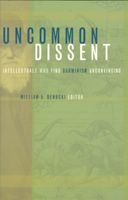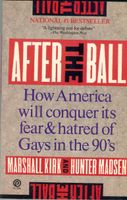Example:
...[Darwinists] divide the world into the moronic masses who reject Darwinism and its consequences, and the smart people (themselves) who believe it. Take Richard Dawkins and Daniel Dennett’s latest attempt to make atheism more alluring to the wider culture. They propose the word “bright” to serve the same role with respect to atheism as the word “gay” serves with respect to homosexuality. Dawkins writes:(Uncommon Dissent: Intellectuals WhoPaul Geisert and Mynga Futrell, of Sacramento, California, have set out to coin a new word, a new “gay.” Like gay, it should be a noun hijacked from an adjective, with its original meaning changed but not too much. Like gay, it should be catchy. . . . Like gay, it should be positive, warm, cheerful, bright. Bright? Yes, bright. Bright is the word, the new noun. I am a bright. You are a bright. She is a bright. We are the brights. Isn’t it about time you came out as a bright? Is he a bright? I can’t imagine falling for a woman who was not a bright. The website www.celeb-atheists.com suggests numerous intellectuals and other famous people are brights. . . . A bright is a person whose world view is free of supernatural and mystical elements. The ethics and actions of a bright are based on a naturalistic world view. . . . You can sign on as a bright at www.the-brights.net.Since an atheistic woridview is best nourished on Darwinism (it was Dawkins, after all, who said that Darwin made it possible to be an intellectually fulfilled atheist), it follows that “brights” are also Darwinists. Perhaps in the future we shall see articles and books about “Darwin’s Bright Idea.”
Find Darwinism Unconvincing
Introduction
Edited by William Dembski)

I chuckled and wondered if that was a joke. I suppose it is not. That's not really how the invention of an identity is done. Perhaps Dawkins needs someone to show him how to go about crafting an image for the sake of emotional manipulations. For instance, the leading minds of Gay© activism would tell him to be sure to change every nerd getting beat up in school into a form of emotional conditioning, for example: "If you don't teach what we say in schools then the Brights© will get beat up! You don't agree with us? Why do you hate all Bright People?" And so on. There is evidence that the Old Press will eat these sort of memes up. It is a way to set the moral vanity typical to journalists to work for the message. Then they'll repeat the story over and over, based on the scripts given them.
Note how Dawkin's form of identity politics comes off as almost a corny joke. Here is more of how it is done, note how emotional conditioning has to be interwoven throughout in contrast to the way Dawkin's rational analysis of what is going on undermines such manipulations:
In any campaign to win over the public, gays must be portrayed as victims in need of protection so that straights will be inclined by reflex to adopt the role of protector. If gays present themselves, instead, as a strong and arrogant tribe promoting a defiantly nonconformist lifestyle, they are more likely to be seen as a public menace that warrants resistance and oppression. For that reason, we must forego the temptation to strut our gay pride publicly to such an extent that we undermine our victim image. And we must walk the fine line between impressing straights with our great numbers, on the one hand, and igniting their hostile paranoia—’They’re all around us!’—on the other.(After the Ball: How America will conquer its fear & hatred of Gays in the 90's
The purpose of victim imagery is to make straights feel very uncomfortable; that is, to jam with shame the self-righteous pride that would ordinarily accompany and reward their antigay belligerence, and to lay groundwork for the process of conversion by helping straights identify with gays and sympathize with their underdog status.To this end, an effective media campaign would make use of symbols and spokespersons that reduce the straight majority’s sense of threat and induce it to lower its guard. [....]
Persons featured in the media campaign should be wholesome and admirable by straight standards, and completely unexceptional in appearance; in a word, they should be indistinguishable from the straights we’d like to reach. In practical terms, this means that cocky mustachioed leathermen, drag queens, and bull dykes would not appear in gay commercials and other public presentations. Conventional young people, middle-aged women, and older folks of all races would be featured, not to mention the parents and straight friends of gays. One could also argue that lesbians should be featured more promi nently than gay men in the early stages of the media campaign. Straights generally have fewer and cloudier preconceptions about lesbians and may feel less hostile toward them. And as women (generally seen as less threatening and more vulnerable than men), lesbians may be more credible objects of sympathy.
It cannot go without saying, incidentally, that groups on the farthest margins of acceptability, such as NAMBLA, must play no part at all in such a campaign. Suspected child molesters will never look like victims. Now, two different messages about the Gay Victim are worth communicating. First, the public should be persuaded that gays are victims of circumstance, that they no more chose their sexual orientation than they did, say, their height, skin color, talents, or limitations. [....]
To suggest in public that homosexuality might be chosen [Oops...] is to open the can of worms labeled ‘moral choice and sin’ and give the religious Intransigents a stick to beat us with. Straights must be taught that it is as natural for some persons to be homosexual as it is for others to be heterosexual: wickedness and seduction have nothing to do with it. And since no choice is involved, gayness can be no more blame worthy than straightness.
By Marshall Kirk and Hunter Madsen :183-184)

The invention of a meme of interest to me:

How it scores:

"Incidentally, note that this ad and others in our portfolio use the term 'homophobia,' not 'homohatred.' While the later term might be more accurate, '-phobia' works better as rhetoric because it's less offensive to straights and suggests, in quasi-clinical terms, that anti-gay feelings stem exclusively from the bigot's own unhealthy psychological hangups and insecurities." (Ib. :221)
But how does that ad score as far as historical accuracy? Not well. For instance, if he was such a "homophobe" then why did he hang around with Gays© so much, to the point that it was rumored he must've been Gay© and so on? Suffice it to say that the point of crafting these memes for the MTVeee generation of the 1990s was not philosophical and historical accuracy. It is interesting to note that Kirk and Madsen begin with evolutionism and end with a cynical disregard for the truth. So their Hitler ad has an irony to it. Who waged a disinformation campaign based on emotional conditioning sans the truth in the past?
There is some truth mixed throughout what they say, i.e. real victimization, yet overall most of Gay© activism (of which this was a handbook) is a disinformation campaign that apparently comes to be misinformation in the memes of the MTVeee generation.
No comments:
Post a Comment